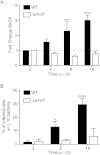Replication of Salmonella enterica Serovar Typhimurium in Human Monocyte-Derived Macrophages
- PMID: 25895967
- PMCID: PMC4468555
- DOI: 10.1128/IAI.00033-15
Replication of Salmonella enterica Serovar Typhimurium in Human Monocyte-Derived Macrophages
Abstract
Salmonella enterica serovar Typhimurium is a common cause of food-borne gastrointestinal illness, but additionally it causes potentially fatal bacteremia in some immunocompromised patients. In mice, systemic spread and replication of the bacteria depend upon infection of and replication within macrophages, but replication in human macrophages is not widely reported or well studied. In order to assess the ability of Salmonella Typhimurium to replicate in human macrophages, we infected primary monocyte-derived macrophages (MDM) that had been differentiated under conditions known to generate different phenotypes. We found that replication in MDM depends greatly upon the phenotype of the cells, as M1-skewed macrophages did not allow replication, while M2a macrophages and macrophages differentiated with macrophage colony-stimulating factor (M-CSF) alone (termed M0) did. We describe how additional conditions that alter the macrophage phenotype or the gene expression of the bacteria affect the outcome of infection. In M0 MDM, the temporal expression of representative genes from Salmonella pathogenicity islands 1 and 2 (SPI1 and SPI2) and the importance of the PhoP/Q two-component regulatory system are similar to what has been shown in mouse macrophages. However, in contrast to mouse macrophages, where replication is SPI2 dependent, we observed early SPI2-independent replication in addition to later SPI2-dependent replication in M0 macrophages. Only SPI2-dependent replication was associated with death of the host cell at later time points. Altogether, our results reveal a very nuanced interaction between Salmonella and human macrophages.
Copyright © 2015, American Society for Microbiology. All Rights Reserved.
Figures






Similar articles
-
A comprehensive study of the contribution of Salmonella enterica serovar Typhimurium SPI2 effectors to bacterial colonization, survival, and replication in typhoid fever, macrophage, and epithelial cell infection models.Virulence. 2011 May-Jun;2(3):208-16. doi: 10.4161/viru.2.3.15894. Epub 2011 May 1. Virulence. 2011. PMID: 21540636 Free PMC article.
-
Microarray-based detection of Salmonella enterica serovar Typhimurium transposon mutants that cannot survive in macrophages and mice.Infect Immun. 2005 Sep;73(9):5438-49. doi: 10.1128/IAI.73.9.5438-5449.2005. Infect Immun. 2005. PMID: 16113260 Free PMC article.
-
Salmonella enterica serovar Typhimurium pathogenicity island 2 is necessary for complete virulence in a mouse model of infectious enterocolitis.Infect Immun. 2005 Jun;73(6):3219-27. doi: 10.1128/IAI.73.6.3219-3227.2005. Infect Immun. 2005. PMID: 15908346 Free PMC article.
-
Delineation of upstream signaling events in the salmonella pathogenicity island 2 transcriptional activation pathway.J Bacteriol. 2004 Jul;186(14):4694-704. doi: 10.1128/JB.186.14.4694-4704.2004. J Bacteriol. 2004. PMID: 15231802 Free PMC article.
-
Salmonella-induced macrophage death: the role of caspase-1 in death and inflammation.Microbes Infect. 2001 Nov-Dec;3(14-15):1201-12. doi: 10.1016/s1286-4579(01)01480-0. Microbes Infect. 2001. PMID: 11755408 Review.
Cited by
-
Nuclear factor kappa B-dependent persistence of Salmonella Typhi and Paratyphi in human macrophages.mBio. 2024 Apr 10;15(4):e0045424. doi: 10.1128/mbio.00454-24. Epub 2024 Mar 18. mBio. 2024. PMID: 38497655 Free PMC article.
-
Effects of Akt Activator SC79 on Human M0 Macrophage Phagocytosis and Cytokine Production.Cells. 2024 May 24;13(11):902. doi: 10.3390/cells13110902. Cells. 2024. PMID: 38891035 Free PMC article.
-
Salmonella actively modulates TFEB in murine macrophages in a growth-phase and time-dependent manner.Microbiol Spectr. 2024 Jan 11;12(1):e0498122. doi: 10.1128/spectrum.04981-22. Epub 2023 Dec 5. Microbiol Spectr. 2024. PMID: 38051049 Free PMC article.
-
Molecular Characterization of Salmonella Serovars Anatum and Ealing Associated with Two Historical Outbreaks, Linked to Contaminated Powdered Infant Formula.Front Microbiol. 2016 Oct 21;7:1664. doi: 10.3389/fmicb.2016.01664. eCollection 2016. Front Microbiol. 2016. PMID: 27818652 Free PMC article.
-
A transcriptomic analysis of the effects of macrophage polarization and endotoxin tolerance on the response to Salmonella.PLoS One. 2022 Oct 14;17(10):e0276010. doi: 10.1371/journal.pone.0276010. eCollection 2022. PLoS One. 2022. PMID: 36240188 Free PMC article.
References
-
- Gordon MA, Banda HT, Gondwe M, Gordon SB, Boeree MJ, Walsh AL, Corkill JE, Hart CA, Gilks CF, Molyneux ME. 2002. Non-typhoidal salmonella bacteraemia among HIV-infected Malawian adults: high mortality and frequent recrudescence. AIDS 16:1633–1641. doi:10.1097/00002030-200208160-00009. - DOI - PubMed
-
- Gordon MA, Kankwatira AMK, Mwafulirwa G, Walsh AL, Hopkins MJ, Parry CM, Faragher EB, Zijlstra EE, Heyderman RS, Molyneux ME. 2010. Invasive non-typhoid salmonellae establish systemic intracellular infection in HIV-infected adults: an emerging disease pathogenesis. Clin Infect Dis 50:953–962. doi:10.1086/651080. - DOI - PubMed
Publication types
MeSH terms
Grants and funding
LinkOut - more resources
Full Text Sources
Research Materials
Miscellaneous

